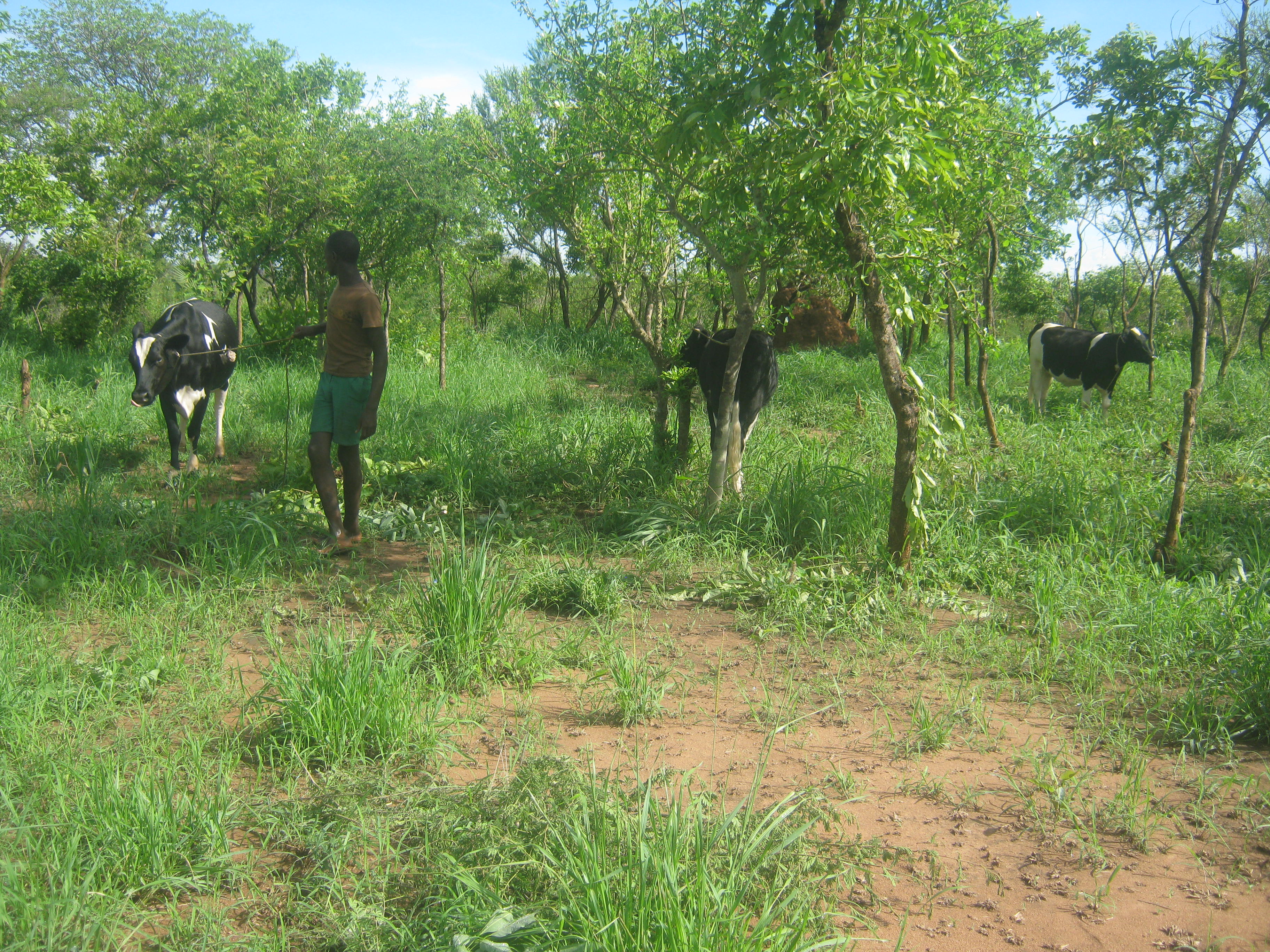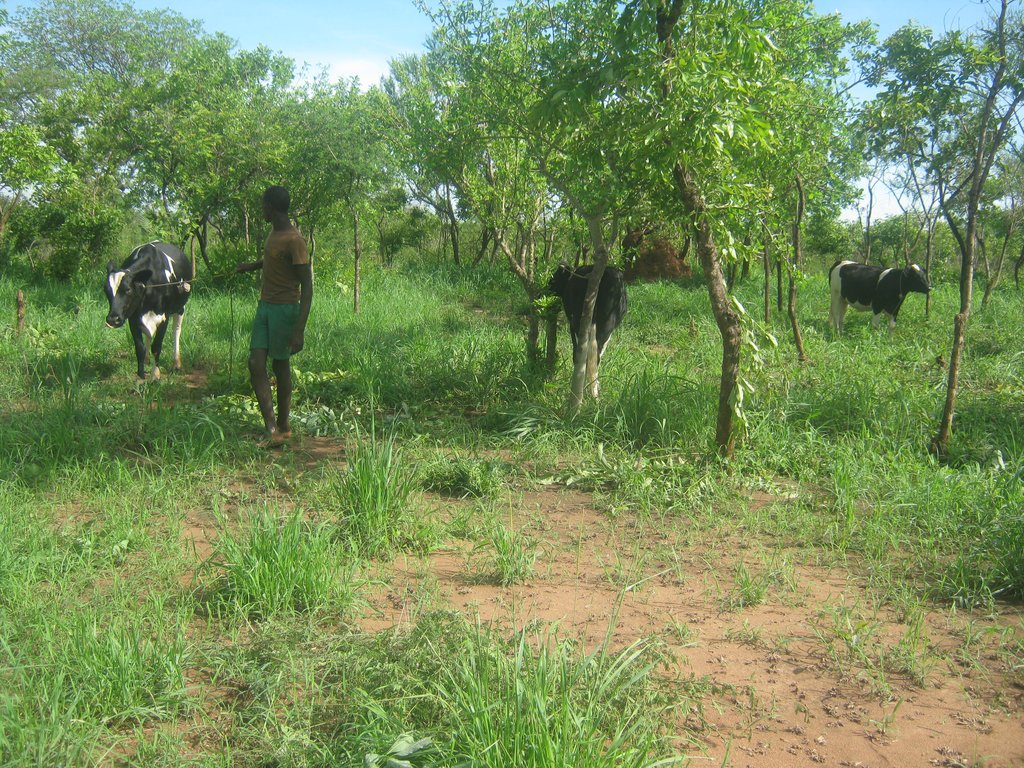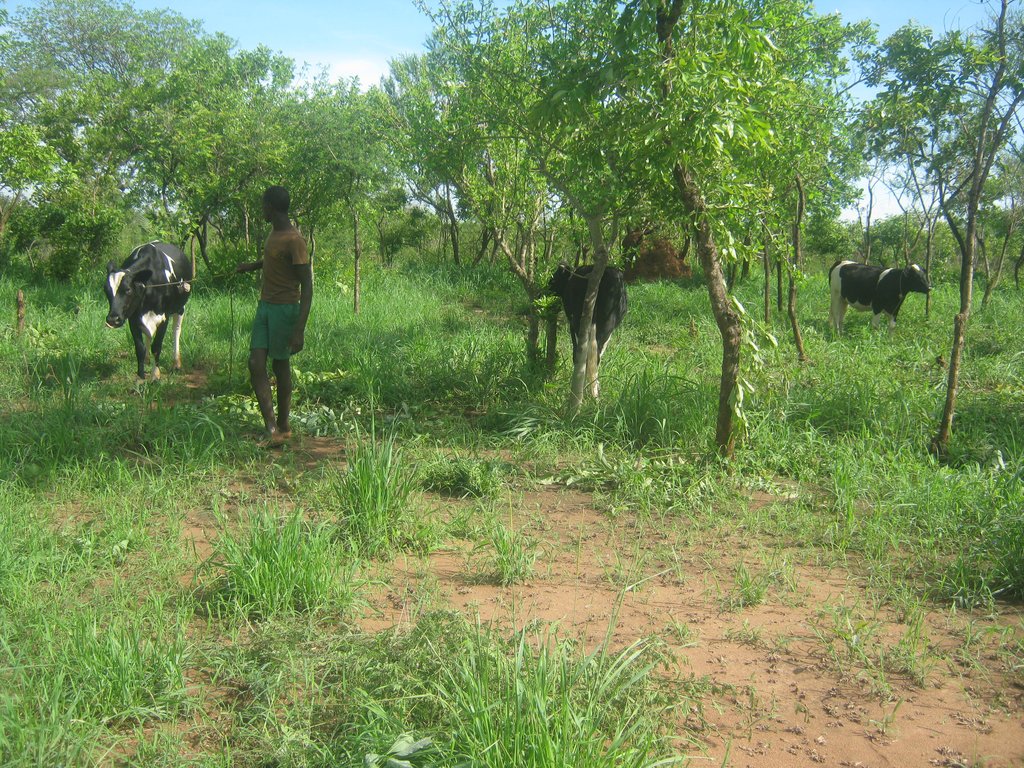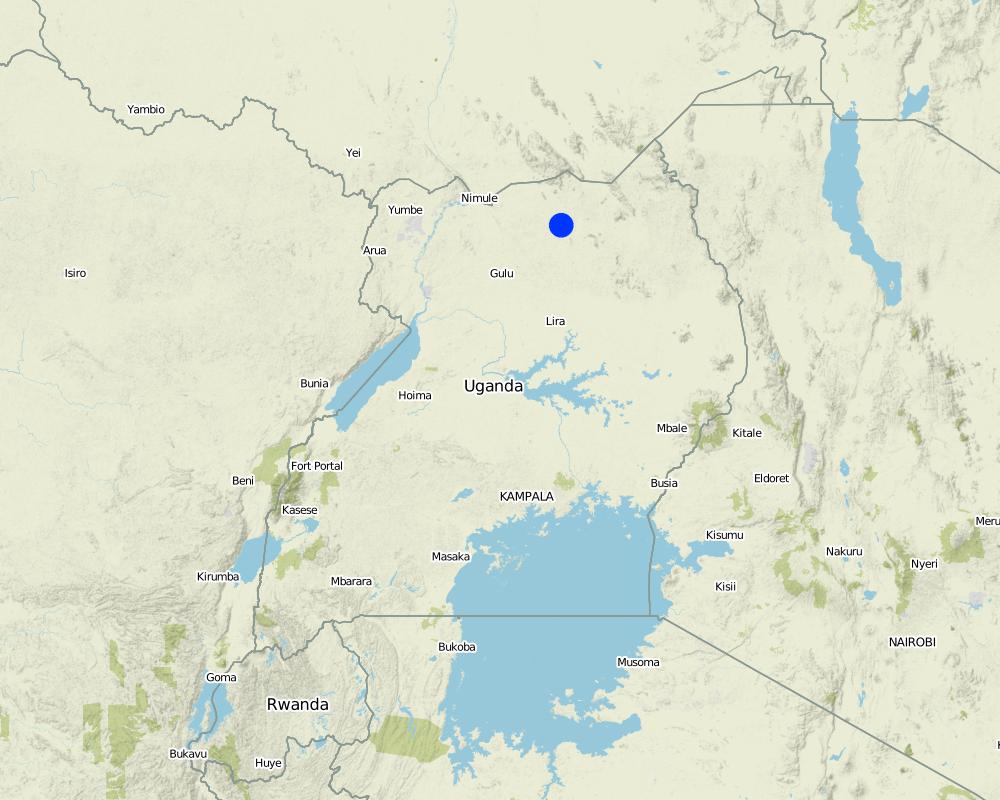Reclamation of indigenous pastures for dairy farming [អ៊ូហ្គង់ដា]
- ការបង្កើត៖
- បច្ចុប្បន្នភាព
- អ្នកចងក្រង៖ betty adoch
- អ្នកកែសម្រួល៖ JOY TUKAHIRWA
- អ្នកត្រួតពិនិត្យច្រើនទៀត៖ John Stephen Tenywa, Nicole Harari, Renate Fleiner, Stephanie Jaquet, Rima Mekdaschi Studer
Lum pi dyang cak
technologies_2321 - អ៊ូហ្គង់ដា
ពិនិត្យមើលគ្រប់ផ្នែក
ពង្រីកមើលទាំងអស់ បង្រួមទាំងអស់1. ព័ត៌មានទូទៅ
1.2 ព័ត៌មានលម្អិតពីបុគ្គលសំខាន់ៗ និងស្ថាប័នដែលចូលរួមក្នុងការវាយតម្លៃ និងចងក្រងឯកសារនៃបច្ចេកទេស
បុគ្គលសំខាន់ម្នាក់ (ច្រើននាក់)
អ្នកប្រើប្រាស់ដី:
Geoffrey Olum
+256-782927838
kitgum district, labongo amida sub county, lukwo village
c/o 39 kitgum district
អ៊ូហ្គង់ដា
ឈ្មោះគម្រោងដែលបានចងក្រងឯកសារ/ វាយតម្លៃលើបច្ចេកទេស (បើទាក់ទង)
Scaling-up SLM practices by smallholder farmers (IFAD)ឈ្មោះអង្គភាពមួយ (ច្រើន) ដែលបានចងក្រងឯកសារ/ វាយតម្លៃបច្ចេកទេស (បើទាក់ទង)
CDE Centre for Development and Environment (CDE Centre for Development and Environment) - ប្រទេសស្វ៊ីស1.3 លក្ខខណ្ឌទាក់ទងទៅនឹងការប្រើប្រាស់ទិន្នន័យដែលបានចងក្រងតាមរយៈ វ៉ូខេត
តើពេលណាដែលទិន្នន័យបានចងក្រង (នៅទីវាល)?
11/05/2017
អ្នកចងក្រង និង(បុគ្គលសំខាន់ៗ)យល់ព្រមទទួលយកនូវលក្ខខណ្ឌនានាទាក់ទងទៅនឹងការប្រើប្រាស់ទិន្នន័យដែលបានចងក្រងតាមរយៈវ៉ូខេត:
បាទ/ចា៎
1.4 សេចក្តីប្រកាសស្តីពីចីរភាពនៃការពណ៌នាពីបច្ចេកទេស
តើបច្ចេកទេសដែលបានពណ៌នានេះមានបញ្ហាដែលផ្តោតលើការធ្លាក់ចុះគុណភាពដី, បើដូច្នេះវាមិនអាចត្រូវបានប្រកាសថាជាបច្ចេកទេសនៃការគ្រប់គ្រងប្រកបដោយចីរភាពទេ?
ទេ
មតិយោបល់:
Reclaimed pastures from crop land are used for grazing the cows.
2. ការពណ៌នាពីបច្ចេកទេស SLM
2.1 ការពណ៌នាដោយសង្ខេបពីបច្ចេកទេស
និយមន័យបច្ចេកទេស:
Dairy cattle (Friesian) are grazed on indigenous pastures to promotes conservation of the indigenous grass species (guinea grass), which protects the soil against soil erosion and promotes biodiversity.
2.2 ការពណ៌នាលម្អិតពីបច្ចេកទេស
ការពណ៌នា:
Indigenous pasture-based dairy farming is a balance between managing the pasture and the cows to maximize sustainable profit and promotes conservation of the indigenous grass species which protects the soil against soil erosion and promotes biodiversity. Northern Uganda has tropical savannah climate which receives moderate amount of rainfall ranging from 750-1000mm per annum. This is sometimes characterised by prolonged dry spells which hamper other economic activities like crop production. Therefore, to avoid the climatic shocks, this technology was introduced by the land user to diversify his economic activity other than only relying on crop production. The land user is a typical subsistence farmer whose major source of income depends on dairy farming to support his livelihood.
In this SLM technology, indigenous pastures are conserved for dairy farming. This is due to the existence of savannah grassland vegetation which provide abundant pastures for cattle grazing. This has favoured the rearing of Friesian cow on a flat landscape. A 30x40meters land was highly preserved for this technology. Five (5) cows are kept on this grazing field occupied by natural pasture (elephant grass) that the land user conserve. These grass are nutritious and the cows healthily and freely graze on them during wet and dry season. However, their movement is controlled by the headsman to avoid crop damage.
In order to maintain these grasses, during dry season, the land user creates a fire line around the conserved grazing area. This is to prevent the spread of wild fire from the nearby bush since it is a serious occurrence in the community. The conserved grass dries up during dry season but the dairy cows graze on it and can still produce high volume of milk as during the wet season. A cow produces daily 15 to 20 litters, they are milked twice a day and the milk is taken to town for sale. Soda ash are given to the cows to raise their appetite for pastures and water. Cows are source of milk, which is sold to generate revenue to the farmer for school fees, medications and cow dung is applied in orchard gardens and tree plantations to boost soil fertility.
To establish this technology, One Friesian cow were donated to the land user by a government project and a grazing field was secured which used to be for crop growing. Water tank placed on the grazing field. The grasses were conserved for the cow and shrub trees also protected for shade. With the help of artificial insemination, more calves were produce and today the land user have five cows that freely graze the area although their movement is controlled by the headsman.
This technology conserve grasses which cover the soil from the effects of soil erosion, reduce incidence of wild fire in the area, the shrubs trees are also protected to provide shade to the cows in the grazing field which promotes farmer managed natural regeneration and the grazing cows spread dung around the field which boost soil fertility.
During dry spells pasture growth is retarded and also becomes less nutritious that makes the cows to become skinny and water shortages. Besides, these cows are prone to pests and disease attacks that requires constant monitoring and treatment.
2.3 រូបភាពនៃបច្ចេកទេស
កំណត់សម្គាល់ទូទៅនៃរូបថត/រូភាព:
The photo shows the natural environment and how they are protected.
2.4 វីដេអូនៃបច្ចេកទេស
ការពណ៌នាសង្ខេប:
diary cow grazing on the natural pastures
កាលបរិច្ឆេទ:
19/05/2017
ទីតាំង:
Kitgum District, Lukwor village,
ឈ្មោះអ្នកថតវីឌីអូ:
Betty Adoch
2.5 ប្រទេស/តំបន់/ទីតាំងកន្លែង ដែលបច្ចេកទេសត្រូវបានអនុវត្ត និងបានគ្រប់ដណ្តប់ដោយការវាយតម្លៃនេះ
ប្រទេស:
អ៊ូហ្គង់ដា
តំបន់/រដ្ឋ/ខេត្ត:
Northern Uganda.
បញ្ជាក់បន្ថែមពីលក្ខណៈនៃទីតាំង:
Kitgum Municipality
មតិយោបល់:
the GPS point indicate the land user farm site
Map
×2.6 កាលបរិច្ឆេទនៃការអនុវត្ត
បង្ហាញឆ្នាំនៃការចុះអនុវត្ត:
2012
ប្រសិនបើមិនច្បាស់ឆ្នាំ សូមបញ្ជាក់កាលបរិច្ឆេទដែលប្រហាក់ប្រហែល:
- តិចជាង 10ឆ្នាំមុន (ថ្មី)
2.7 ការណែនាំពីបច្ចេកទេស
សូមបញ្ជាក់តើបច្ចេកទេសត្រូវបានណែនាំឱ្យអនុវត្តដោយរបៀបណា:
- តាមរយៈគម្រោង / អន្តរាគមន៍ពីខាងក្រៅ
មតិយោបល់ (ប្រភេទនៃគម្រោង ។ល។):
knowledge provided by Dairy Development Authority (DDA).
3. ចំណាត់ថ្នាក់នៃបច្ចេកទេស SLM
3.1 គោលបំណងចម្បង (១ ឬច្រើន) នៃបច្ចេកទេសនេះ
- ធ្វើឱ្យប្រសើរឡើងនូវផលិតកម្ម
- កាត់បន្ថយ, បង្ការ, ស្តារឡើងវិញនូវការធ្លាក់ចុះគុណភាពដី
- អភិរក្សប្រព័ន្ធអេកូឡូស៊ី
- អភិរក្ស/ធ្វើឱ្យប្រសើរឡើងជីវចម្រុះ
- បន្ស៊ាំទៅនឹងការប្រែប្រួលអាកាសធាតុ/គ្រោះមហន្តរាយ និងផលប៉ះពាល់របស់វា
- បង្កើតផលប្រយោជន៍សេដ្ឋកិច្ច
3.2 ប្រភេទដីប្រើប្រាស់មួយប្រភេទ (ច្រើនប្រភេទ) ដែលបានអនុវត្តបច្ចេកទេស

ដីសម្រាប់ចិញ្ចឹមសត្វ
ដីវាលស្មៅធំៗ:
- បែងចែកវាលស្មៅជាប្លុក
ដីវាលស្មៅតូចៗ/ ផលិតកម្មចំណី:
- បង្កើនវាលស្មៅ
ប្រភេទសត្វ និងផលិតផលចម្បងៗ:
exotic breed (Friesian cattle) for milk production.
មតិយោបល់:
artificial insemination done to acquire a calf.
ប្រសិនបើដីមានការប្រែប្រួលបន្ទាប់ពីការអនុវត្តបច្ចេកទេស សូមបញ្ជាក់ពីការប្រើប្រាស់ដីមុនពេលអនុវត្តន៍បច្ចេកទេស:
cropland
3.3 ព័ត៌មានបន្ថែមអំពីអ្នកប្រើប្រាស់ដី
ការផ្គត់ផ្គង់ទឹកនៅកន្លែងអនុវត្តបច្ចេកទេស:
- ទឹកភ្លៀង
មតិយោបល់:
pastures depends on rain for growth
ចំនួនសារដែលដាំដំណាំក្នុងមួយឆ្នាំ:
- 2
សូមបញ្ជាក់:
cows are milk on a daily basis and one cows generates 15-20 litres of milk
ដង់ស៊ីតេនៃសត្វចិញ្ចឹម (បើពាក់ព័ន្ធ):
Five (5) cows
3.4 ក្រុម SLM ដែលបច្ចេកទេសស្ថិតនៅក្នុង
- កសិរុក្ខកម្ម
- កសិរុក្ខកម្ម (pastoralism) និងការគ្រប់គ្រងដីសម្រាប់ចិញ្ចឹមសត្វ
- ធ្វើឱ្យប្រសើរឡើងនូវការបង្កាត់ពូជរុក្ខជាតិ/ សត្វ
3.5 ការសាយភាយនៃបច្ចេកទេស
បញ្ជាក់ពីការសាយភាយនៃបច្ចេកទេស:
- ត្រូវបានផ្សព្វផ្សាយត្រឹមតំបន់មួយ
ប្រសិនបើបច្ចេកទេសត្រូវបានសាយភាយពាសពេញតំបន់ណាមួយ សូមកំណត់ទំហំផ្ទៃដីអនុវត្តន៍:
- < 0.1 គម2 (10 ហិកតា)
មតិយោបល់:
2 acres of land gazetted for grazing the cows.
3.6 វិធានការ SLM ដែលបញ្ចូលនូវបច្ចេកទេស

វិធានការរុក្ខជាតិ
- V1: ឈើធំៗ និងដើមឈើតូចៗ
- V2: ស្មៅនិងរុក្ខជាតិៗដែលដុះមានអាយុមិនលើសពី 2ឆ្នាំ

វិធានការគ្រប់គ្រង
- M1: ការផ្លាស់ប្តូរប្រភេទដីប្រើប្រាស់
មតិយោបល់:
crop production garden was converted into a grazing ground.
3.7 កំណត់ប្រភេទនៃការធ្លាក់ចុះគុណភាពដីសំខាន់ៗដែលបច្ចេកទេសនេះបានដោះស្រាយ

ការហូរច្រោះដីដោយសារទឹក
- Wt: ការបាត់ដីស្រទាប់លើដោយការហូរច្រោះ
- Wg: ការកកើតឡើងនូវកំទេចកំទីដីស្រទាប់ក្រោម

ការបាត់ដីដោយសារខ្យល់
- Et: ការបាត់បង់ដីស្រទាប់លើ
- Ed: អតិផរណា និង ការទម្លាក់

ការធ្លាក់ចុះជីវសាស្ត្រនៃដី
- Bc: ការថយចុះនូវគម្របរុក្ខជាតិ
- Bh: ការបាត់បង់ទីជំរក
- Bf: ផលប៉ះពាល់ដែលបណ្តាលមកពីភ្លើងឆេះ
មតិយោបល់:
Dairy farming protects the soil from human induced activities like crop cultivation which exposes the top soils for erosion.
3.8 ការពារ កាត់បន្ថយ ឬស្តារឡើងវិញនៃការធ្លាក់ចុះគុណភាពដី
បញ្ជាក់ពីគោលដៅរបស់បច្ចេកទេស ដែលផ្តោតទៅការធ្លាក់ចុះគុណភាពដី:
- ការការពារការធ្លាក់ចុះគុណភាពដី
- ការកាត់បន្ថយការធ្លាក់ចុះគុណភាពដី
មតិយោបល់:
promotes soil conservation
4. បច្ចេកទេសជាក់លាក់ សកម្មភាពអនុវត្ត ធាតុចូល និងថ្លៃដើម
4.1 គំនូសបច្ចេកទេសនៃបច្ចេកទេសនេះ
4.2 លក្ខណៈពិសេសនៃបច្ចេកទេស/ ពណ៌នាពីគំនូរបច្ចេកទេស
2 acres of land measuring 30x40 meters secured for grazing the cows. A kraal is constructed on the grazing field to accommodate the cows in the night. Pegging is done to prevent the cows from moving to cropland and after some time like afternoon the cows are shifted to another spot to graze. But also at time the cows are left to graze in the field with controlled movement. A kraal/shade is constructed, roofed with 5 pieces of iron sheet and supported by timbers that stands at a height of about 4meters.
4.3 ព័ត៌មានទូទៅដែលពាក់ព័ន្ធនឹងការគណនាធាតុចូល និងថ្លៃដើម
កំណត់របៀបនៃការគណនាថ្លៃដើម និងធាតុចូល:
- ក្នុងតំបន់អនុវត្តបច្ចេកទេស
កំណត់ទំហំ និងឯកត្តាផ្ទៃដី:
2acres
ផ្សេងៗ/ រូបិយប័ណ្ណជាតិ (បញ្ជាក់):
UGX
កំណត់អត្រាប្តូរប្រាក់ពីដុល្លាទៅរូបិយប័ណ្ណតំបន់ (បើទាក់ទង)៖ 1 ដុល្លារ =:
3718,0
កំណត់ថ្លៃឈ្នួលជាមធ្យមនៃការជួលកម្លាំងពលកម្មក្នុងមួយថ្ងៃ:
3000shs
4.4 សកម្មភាពបង្កើត
| សកម្មភាព | ប្រភេទវិធានការ | ពេលវេលា | |
|---|---|---|---|
| 1. | clearing thony trees | សារពើរុក្ខជាតិ | dry season |
| 2. | regeneration of pastures | សារពើរុក្ខជាតិ | dry season |
| 3. | constructing cattle shade | សារពើរុក្ខជាតិ | dry and wet |
មតិយោបល់:
Dairy farming is easy to manage by a a farmer.
4.5 ថ្លៃដើម និងធាតុចូលដែលត្រូវការសម្រាប់ការបង្កើតបច្ចេកទេស
មតិយោបល់:
Its quite expensive at the initial stage of technology establishment but maintenance is easy.
4.6 សកម្មភាពថែទាំ
| សកម្មភាព | ប្រភេទវិធានការ | ពេលវេលា/ ភាពញឹកញាប់ | |
|---|---|---|---|
| 1. | Slashing the over grown grass | សារពើរុក្ខជាតិ | dry and wet |
| 2. | constant removal of thony trees | សារពើរុក្ខជាតិ | dry and wet |
| 3. | Refilling the water tank | ការគ្រប់គ្រង | wet and dry season |
| 4. | Rotational pegging | សារពើរុក្ខជាតិ | Dry and wet seasons |
| 5. | Taking/returing of cows to kraal every evening | dry and wet seasons | |
| 6. | Replacing ropes to tie the cows during pegging | dry and wet seasons |
4.7 កំណត់ថ្លៃដើមសម្រាប់ការថែទាំ/ សកម្មភាពរបស់បច្ចេកទេស (ក្នុងរយៈពេលមួយឆ្នាំ)
មតិយោបល់:
The management is easy by the farmer.
4.8 កត្តាសំខាន់បំផុតដែលមានឥទ្ធិពលដល់ការចំណាយ
ពណ៌នាពីកត្តាប៉ះពាល់ចម្បងៗទៅលើថ្លៃដើម:
The labour for firebreaks during dry seasons and maintaining the farm.
5. លក្ខណៈបរិស្ថានធម្មជាតិ និងមនុស្ស
5.1 អាកាសធាតុ
បរិមាណទឹកភ្លៀងប្រចាំឆ្នាំ
- < 250 មម
- 251-500 មម
- 501-750 មម
- 751-1,000 មម
- 1,001-1,500 មម
- 1,501-2,000 មម
- 2,001-3,000 មម
- 3,001-4,000 មម
- > 4,000 មម
កំណត់បរិមាណទឹកភ្លៀង (បើដឹង) ជា មីលីម៉ែត្រ:
900,00
លក្ខណៈពិសេស/ មតិយោបល់លើរដូវភ្លៀង:
heavy rain in april, may, june, august, september and october. these reduces in july, november,december january , febuary and march.
បញ្ជាក់ឈ្មោះឯកសារយោងនៃស្ថានីយឧតុនិយម:
kitgum weather station
តំបន់កសិអាកាសធាតុ
- មានភ្លៀងមធ្យម
savanna climate where rainfall is moderate and unreliable with hot temperatures throughtout the year.
5.2 សណ្ឋានដី
ជម្រាលជាមធ្យម:
- រាបស្មើ (0-2%)
- ជម្រាលតិចតួច (3-5%)
- មធ្យម (6-10%)
- ជម្រាលខ្ពស់បន្តិច (11-15%)
- ទីទួល (16-30%)
- ទីទួលចោត (31-60%)
- ទីទួលចោតខ្លាំង (>60%)
ទម្រង់ដី:
- ខ្ពង់រាប
- កំពូលភ្នំ
- ជម្រាលភ្នំ
- ជម្រាលទួល
- ជម្រាលជើងភ្នំ
- បាតជ្រលងភ្នំ
តំបន់តាមរយៈកម្ពស់ :
- 0-100 ម
- 101-500 ម
- 501-1,000 ម
- 1,001-1,500 ម
- 1,501-2,000 ម
- 2,001-2,500 ម
- 2,501-3,000 ម
- 3,001-4,000 ម
- > 4,000 ម
បញ្ជាក់ថាតើបច្ចេកទេសនេះត្រូវបានអនុវត្តន៍នៅក្នុង:
- មិនពាក់ព័ន្ធទាំងអស់
មតិយោបល់ និងបញ្ចាក់បន្ថែមអំពីសណ្ឋានដី :
generally flat landscape.
5.3 ដី
ជម្រៅដីជាមធ្យម:
- រាក់ខ្លាំង (0-20 សម)
- រាក់ (21-50 សម)
- មធ្យម (51-80 សម)
- ជ្រៅ (81-120 សម)
- ជ្រៅខ្លាំង (> 120 សម)
វាយនភាពដី (ស្រទាប់លើ):
- មធ្យម (ល្បាយ, ល្បាប់)
វាយនភាពដី (> 20 សម ស្រទាប់ក្នុង):
- មធ្យម (ល្បាយ, ល្បាប់)
សារធាតុសរីរាង្គនៅស្រទាប់ដីខាងលើ:
- មធ្យម (1-3%)
បើអាចសូមភ្ជាប់ការពណ៌នាពីដីឱ្យបានច្បាស់ ឬព័ត៌មានដែលអាចទទួលបាន ឧ. ប្រភេទដី, pH ដី/ ជាតិអាស៊ីត, សមត្ថភាពផ្លាស់ប្តូរកាចុង, វត្តមាននីត្រូសែន, ភាពប្រៃ ។ល។:
fertile soil that support plant growth
5.4 ទឹកដែលអាចទាញមកប្រើប្រាស់បាន និងគុណភាពទឹក
នីវ៉ូទឹកក្រោមដី:
5-50 ម
ទឹកលើដីដែលអាចទាញយកប្រើប្រាស់បាន:
ល្អ
គុណភាពទឹក (មិនបានធ្វើប្រត្តិកម្ម):
ទឹកពិសារដែលមានគុណភាពល្អ
តើមានបញ្ហាភាពទឹកប្រៃហូរចូលមកដែរឬទេ?
ទេ
តើទឹកជំនន់កំពុងកើតមាននៅតំបន់នេះដែររឺទេ?
ទេ
មតិយោបល់ និងលក្ខណៈពិសេសផ្សេងៗទៀតលើគុណភាព និងបរិមាណទឹក :
water is safe for animal consumption.
5.5 ជីវៈចម្រុះ
ភាពសម្បូរបែបនៃប្រភេទ:
- ខ្ពស់
ភាពសម្បូរបែបនៃទីជម្រក:
- ខ្ពស់
មតិយោបល់ និងលក្ខណៈពិសេសផ្សេងទៀតលើជីវចម្រុះ:
cows,goats,wild rats and plant species like shrub trees, grass all coexist in the area.
5.6 លក្ខណៈនៃអ្នកប្រើប្រាស់ដីដែលអនុវត្តបច្ចេកទេស
នៅមួយកន្លែង ឬពនេចរ :
- នៅមួយកន្លែង
ទីផ្សារនៃប្រព័ន្ធផលិតកម្ម:
- ពាក់កណ្តាលពាណិជ្ជកម្ម (ផ្គត់ផ្គង់ខ្លួនឯង/ ពាណិជ្ជកម្ម
ចំណូលក្រៅកសិកម្ម:
- តិចជាង 10% នៃចំណូល
កម្រិតជីវភាព:
- មធ្យម
ឯកជន ឬក្រុម:
- ធ្វើខ្លួនឯង/ គ្រួសារ
កម្រិតប្រើប្រាស់គ្រឿងយន្ត:
- ប្រើកម្លាំងពលកម្ម
យេនឌ័រ:
- បុរស
អាយុរបស់អ្នកប្រើប្រាស់ដី:
- វ័យកណ្តាល
- មនុស្សចាស់
សូមបញ្ជាក់ពីលក្ខណៈពាក់ព័ន្ធផ្សេងទៀតអំពីអ្នកប្រើប្រាស់ដី:
the land user supply a dairy in town where his farm milk are sold.
5.7 ទំហំផ្ទៃដីជាមធ្យមនៃដីផ្ទាល់ខ្លួន ឬជួលគេដែលបានអនុវត្តបច្ចេកទេស
- < 0.5 ហិកតា
- 0.5-1 ហិកតា
- 1-2 ហិកតា
- 2-5 ហិកតា
- 5-15 ហិកតា
- 15-50 ហិកតា
- 50-100 ហិកតា
- 100-500 ហិកតា
- 500-1,000 ហិកតា
- 1,000-10,000 ហិកតា
- > 10,000 ហិកតា
តើផ្ទៃដីនេះចាត់ទុកជាទំហំកម្រិតណាដែរ ខ្នាតតូច មធ្យម ឬខ្នាតធំ (ធៀបនឹងបរិបទតំបន់)?
- ខ្នាតតូច
5.8 ភាពជាម្ចាស់ដី កម្មសិទ្ធប្រើប្រាស់ដី និងកម្មសិទ្ធប្រើប្រាស់ទឹក
ភាពជាម្ចាស់ដី:
- ឯកជន មិនមានកម្មសិទ្ធ
កម្មសិទ្ធិប្រើប្រាស់ដី:
- ឯកជន
កម្មសិទ្ធប្រើប្រាស់ទឹក:
- ជាក្រុម (មានដែនកំណត់)
មតិយោបល់:
need to acquire land title for security purposes.
5.9 ការប្រើប្រាស់សេវាកម្ម និងហេដ្ឋារចនាសម្ព័ន្ធ
សុខភាព:
- មិនល្អ
- មធ្យម
- ល្អ
ការអប់រំ:
- មិនល្អ
- មធ្យម
- ល្អ
ជំនួយបច្ចេកទេស:
- មិនល្អ
- មធ្យម
- ល្អ
ការងារ (ឧ. ការងារក្រៅកសិដ្ឋាន):
- មិនល្អ
- មធ្យម
- ល្អ
ទីផ្សារ:
- មិនល្អ
- មធ្យម
- ល្អ
ថាមពល:
- មិនល្អ
- មធ្យម
- ល្អ
ផ្លូវ និងការដឹកជញ្ជូន:
- មិនល្អ
- មធ្យម
- ល្អ
ទឹកផឹក និងអនាម័យ:
- មិនល្អ
- មធ្យម
- ល្អ
សេវាកម្មហិរញ្ញវត្ថុ:
- មិនល្អ
- មធ្យម
- ល្អ
6. ផលប៉ះពាល់ និងការសន្និដ្ឋាន
6.1 ផលប៉ះពាល់ក្នុងបរិវេណអនុវត្តបច្ចេកទេសដែលកើតមាន
ផលប៉ះពាល់លើសេដ្ឋកិច្ចសង្គម
ផលិតផល
ផលិតកម្មចំណីសត្វ
គុណភាពមុន SLM:
low
គុណភាពក្រោយ SLM:
high
មតិយោបល់/ ការបញ្ជាក់:
Conserved pastures for cows.
គុណភាពចំណីសត្វ
គុណភាពមុន SLM:
low
គុណភាពក្រោយ SLM:
high
មតិយោបល់/ ការបញ្ជាក់:
nutritious for grazing
ផលិតកម្មសត្វ
គុណភាពមុន SLM:
low
គុណភាពក្រោយ SLM:
high
មតិយោបល់/ ការបញ្ជាក់:
due to increased fodder production
ទឹកដែលអាចទាញមកប្រើប្រាស់បាន និងគុណភាពទឹក
ទឹកដែលអាចប្រើប្រាស់បានសម្រាប់ការចិញ្ចឹមសត្វ
គុណភាពមុន SLM:
low
គុណភាពក្រោយ SLM:
high
មតិយោបល់/ ការបញ្ជាក់:
Water is stored in a tank for the animals.
ចំណូល និងថ្លៃដើម
ចំណូលក្នុងកសិដ្ឋាន
គុណភាពមុន SLM:
low
គុណភាពក្រោយ SLM:
high
មតិយោបល់/ ការបញ្ជាក់:
Through sales of milk.
ភាពខុសគ្នាផ្នែកសេដ្ឋកិច្ច
គុណភាពមុន SLM:
highl
គុណភាពក្រោយ SLM:
low
មតិយោបល់/ ការបញ្ជាក់:
Has his source of income.
ផលប៉ះពាល់ទៅលើវប្បធម៌សង្គម
សន្តិសុខស្បៀង/ ភាពគ្រប់គ្រាន់ខ្លួនឯង
គុណភាពមុន SLM:
low
គុណភាពក្រោយ SLM:
high
មតិយោបល់/ ការបញ្ជាក់:
Milk provide food to the land user.
ចំណេះដឹង SLM / ការធ្លាក់ចុះគុណភាពដី
គុណភាពមុន SLM:
low
គុណភាពក្រោយ SLM:
high
មតិយោបល់/ ការបញ្ជាក់:
Aware of the importance of soil conservation.
ការកាត់បន្ថយជម្លោះ
គុណភាពមុន SLM:
low
គុណភាពក្រោយ SLM:
high
មតិយោបល់/ ការបញ្ជាក់:
The grazing zone is secure from land disputes.
ផលប៉ះពាល់ទៅលើអេកូឡូស៊ី
ដី
សំណើមដី
គុណភាពមុន SLM:
low
គុណភាពក្រោយ SLM:
high
មតិយោបល់/ ការបញ្ជាក់:
Grass cover soil from the effects of evaporations retaining more soil moistures.
គម្របដី
គុណភាពមុន SLM:
low
គុណភាពក្រោយ SLM:
high
មតិយោបល់/ ការបញ្ជាក់:
Grass protects the soil.
ការបាត់បង់ដី
គុណភាពមុន SLM:
high
គុណភាពក្រោយ SLM:
low
មតិយោបល់/ ការបញ្ជាក់:
Prevents soil erosion.
ជីវចម្រុះ៖ ដំណាំ, សត្វ
ដំណាំគម្រប
គុណភាពមុន SLM:
low
គុណភាពក្រោយ SLM:
high
មតិយោបល់/ ការបញ្ជាក់:
Plants and trees exists.
ភាពសម្បូរបែបនៃរុក្ខជាតិ
គុណភាពមុន SLM:
low
គុណភាពក្រោយ SLM:
high
មតិយោបល់/ ការបញ្ជាក់:
Conservation of trees and grass for the animals.
ការកាត់បន្ថយហានិភ័យនៃគ្រោះមហន្តរាយ និងគ្រោះអាកាសធាតុ
ការបំភាយនៃកាបូន និងឧស្ម័នផ្ទះកញ្ចក់
គុណភាពមុន SLM:
high
គុណភាពក្រោយ SLM:
low
មតិយោបល់/ ការបញ្ជាក់:
Plants acts as carbon sink.
6.2 ផលប៉ះពាល់ក្រៅបរិវេណអនុវត្តបច្ចេកទេសដែលកើតមាន
ទឹកដែលអាចទាញមកប្រើប្រាស់បាន
គុណភាពមុន SLM:
low
គុណភាពក្រោយ SLM:
high
មតិយោបល់/ ការបញ្ជាក់:
Water source has been secured to constantly supply water for the animals during wet and dry seasons and also for other domestic activities.
Buffering/សមត្ថភាពចម្រោះ
គុណភាពមុន SLM:
low
គុណភាពក្រោយ SLM:
high
មតិយោបល់/ ការបញ្ជាក់:
Plants roots filters the underground water.
6.3 ភាពប្រឈម និងភាពរួសនៃបច្ចេកទេសទៅនឹងការប្រែប្រួលអាកាសធាតុ និងគ្រោះអាកាសធាតុ/ គ្រោះមហន្តរាយ (ដែលដឹងដោយអ្នកប្រើប្រាស់ដី)
ការប្រែប្រួលអាកាសធាតុ
ការប្រែប្រួលអាកាសធាតុ
| រដូវកាល | ប្រភេទនៃការប្រែប្រួលអាកាសធាតុ/ព្រឹត្តិការណ៍ | លក្ខណៈឆ្លើយតបនៃបច្ចេកទេសទៅនឹងការប្រែប្រួលអាកាសធាតុ | |
|---|---|---|---|
| សីតុណ្ហភាពប្រចាំឆ្នាំ | កើនឡើង | មធ្យម | |
| សីតុណ្ហភាពប្រចាំរដូវកាល | រដូវប្រាំង | កើនឡើង | មធ្យម |
| បរិមាណទឹកភ្លៀងប្រចាំឆ្នាំ | ថយចុះ | មធ្យម | |
| បរិមាណទឹកភ្លៀងប្រចាំរដូវកាល | សើម/រដូវភ្លៀង | ថយចុះ | មធ្យម |
គ្រោះអាកាសធាតុ (មហន្តរាយ)
គ្រោះមហន្តរាយធម្មជាតិ
| លក្ខណៈឆ្លើយតបនៃបច្ចេកទេសទៅនឹងការប្រែប្រួលអាកាសធាតុ | |
|---|---|
| ព្យុះភ្លៀងតាមតំបន់ | មធ្យម |
| ព្យុះរន្ទះតាមតំបន់ | មធ្យម |
| ព្យុះទឹកកកតាមតំបន់ | មធ្យម |
គ្រោះមហន្តរាយអាកាសធាតុ
| លក្ខណៈឆ្លើយតបនៃបច្ចេកទេសទៅនឹងការប្រែប្រួលអាកាសធាតុ | |
|---|---|
| រលកកម្តៅ | មធ្យម |
| រាំងស្ងួត | មធ្យម |
| ភ្លើងឆេះ | មធ្យម |
គ្រោះមហន្តរាយជីវៈសាស្ត្រ
| លក្ខណៈឆ្លើយតបនៃបច្ចេកទេសទៅនឹងការប្រែប្រួលអាកាសធាតុ | |
|---|---|
| ការរាតត្បាតនៃជំងឺ | មធ្យម |
| ការមានបញ្ហាសត្វល្អិត/ដង្កូវ | មធ្យម |
មតិយោបល់:
the dairy animals are healthy
6.4 ការវិភាគថ្លៃដើម និងអត្ថប្រយោជន៍
តើផលចំណេញ និងថ្លៃដើមត្រូវបានប្រៀបធៀបគ្នាយ៉ាងដូចម្តេច (ទស្សនៈរបស់អ្នកប្រើប្រាស់ដី)?
រយៈពេលខ្លី:
វិជ្ជមានតិចតួច
រយៈពេលវែង:
វិជ្ជមានខ្លាំង
តើផលចំណេញ និងការថែទាំ/ ជួសជុលត្រូវបានប្រៀបធៀបគ្នាយ៉ាងដូចម្តេច (ទស្សនៈរបស់អ្នកប្រើប្រាស់ដី)?
រយៈពេលខ្លី:
វិជ្ជមាន
រយៈពេលវែង:
វិជ្ជមានខ្លាំង
មតិយោបល់:
Dairy cows produces a calf once a year after artificial insemination.
6.5 ការទទួលយកបច្ចេកទេស
- 1-10%
បើអាច សូមបញ្ជាក់ពីបរិមាណ (ចំនួនគ្រួសារ និង/ ឬតំបន់គ្របដណ្តប់):
05 household
ក្នុងចំណោមគ្រួសារទាំងអស់ដែលអនុវត្តបច្ចេកទេស តើមានប៉ុន្មានគ្រួសារដែលចង់ធ្វើដោយខ្លួនឯង ដោយមិនទទួលបានសម្ភារៈលើកទឹកចិត្ត/ប្រាក់ឧបត្ថម្ភ?:
- 0-10%
មតិយោបល់:
Farmers uses their own capital.
6.6 ការបន្សុំា
តើថ្មីៗនេះ បច្ចេកទេសនេះត្រូវបានកែតម្រូវដើម្បីបន្ស៊ាំទៅនឹងស្ថានភាពប្រែប្រួលដែរឬទេ?
បាទ/ចា៎
បើឆ្លើយបាទ/ ចា៎ សូមកំណត់ថាតើស្ថានភាពប្រែប្រួលមួយណាត្រូវបានបន្ស៊ាំ:
- ការប្រែប្រួលអាកាសធាតុ/គ្រោះមហន្តរាយធម្មជាតិ
6.7 ភាពខ្លាំង/ គុណសម្បត្តិ/ ឱកាសនៃបច្ចេកទេស
| ភាពខ្លាំង/ គុណសម្បត្តិ/ ឱកាសនៅកន្លែងរបស់អ្នកប្រើប្រាស់ដី |
|---|
| Soils are protected from the effects of erosion. |
| Cow dungs are used as manure on orchard gardens. |
| ភាពខ្លាំង/ គុណសម្បត្តិ/ ឱកាស ទស្សនៈរបស់បុគ្គលសំខាន់ៗ |
|---|
| Conservation of soil and improved soil fertility. |
| Vegetation modifies the micro climate through the conserved pastures. |
| Land protections from degradation by erosion. |
6.8 ភាពខ្សោយ/ គុណវិបត្តិ/ ហានិភ័យនៃបច្ចេកទេស និងវិធីសាស្ត្រដោះស្រាយ
| ភាពខ្សោយ/ គុណវិបត្តិ/ ហានិភ័យ ទស្សនៈរបស់អ្នកប្រើប្រាស់ដី | តើបច្ចេកទេសទាំងនោះបានដោះស្រាយបញ្ហាដូចម្តេច? |
|---|---|
| Pests and diseases that affects the cows. | Spraying and treatments. |
| Inadequate pastures during dry seasons. | Supplement with maize brands,banana leaves, and hey. |
| ភាពខ្សោយ/ គុណវិបត្តិ/ ហានិភ័យ ទស្សនៈរបស់អ្នកចងក្រងឬបុគ្គលសំខាន់ៗ | តើបច្ចេកទេសទាំងនោះបានដោះស្រាយបញ្ហាដូចម្តេច? |
|---|---|
| Water shortage during dry season. | Planning to build a better and larger tank. |
| Failure of artificial insemination. | Need to acquire a Friesian bull. |
7. ឯកសារយោង និងវេបសាយ
7.1 វិធីសាស្ត្រ/ ប្រភពនៃព័ត៌មាន
- តាមការចុះទីវាល ការស្រាវជ្រាវនៅទីវាល
1
- ការសម្ភាសន៍ជាមួយអ្នកប្រើប្រាស់ដី
1
ការតភ្ជាប់ និងម៉ូឌុល
ពង្រីកមើលទាំងអស់ បង្រួមទាំងអស់ការតភ្ជាប់
គ្មានការតភ្ជាប់
ម៉ូឌុល
គ្មានម៉ូឌុល






